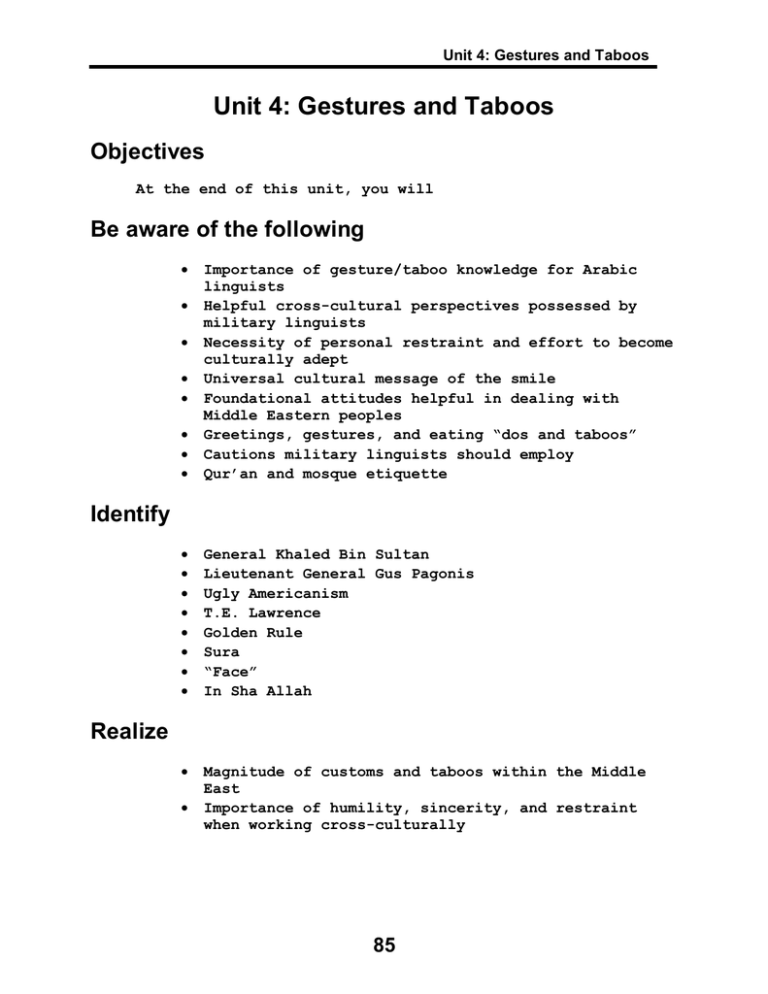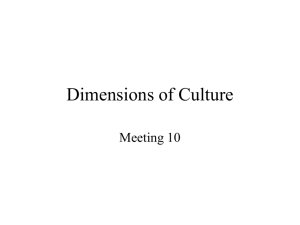Unit 4: Gestures and Taboos Objectives Be aware of the following
advertisement

Unit 4: Gestures and Taboos Unit 4: Gestures and Taboos Objectives At the end of this unit, you will Be aware of the following • Importance of gesture/taboo knowledge for Arabic linguists • Helpful cross-cultural perspectives possessed by military linguists • Necessity of personal restraint and effort to become culturally adept • Universal cultural message of the smile • Foundational attitudes helpful in dealing with Middle Eastern peoples • Greetings, gestures, and eating “dos and taboos” • Cautions military linguists should employ • Qur’an and mosque etiquette Identify • • • • • • • • General Khaled Bin Sultan Lieutenant General Gus Pagonis Ugly Americanism T.E. Lawrence Golden Rule Sura “Face” In Sha Allah Realize • Magnitude of customs and taboos within the Middle East • Importance of humility, sincerity, and restraint when working cross-culturally 85 Unit 4: Gestures and Taboos Unit 4: Gestures and Taboos “When the time came for me and accompanying staff to perform the noon prayers, I was touched to notice that the division had prepared a place for us to make our ablutions and pray. A soldier was there with a jug of water.” -- General Khaled Bin Sultan, Desert Warrior, p. 201. Manners, morals, customs and taboos--it is impossible to know all the elaborate and complex rules which govern interactions within a given society or culture. The task overwhelms. Defense Language Institute Foreign Language Center personnel have excellent resources available to assist. The Saudi-Arabic Headstart Cultural Notes booklet (AN0050S) gives well-organized, detailed information. The 5th Special Forces Group (ABN) Military Intelligence Company’s 2ND Edition Arab Customs and Culture booklet is easily understood and thorough. The handbook used by the United States Air Force Special Operations School (AD00020T0) entitled Middle East Orientation Course gives helpful insight into customs and taboos. In addition, it discusses useful perspectives trainers and supervisors can employ in cross-cultural settings. The purpose here is not to rephrase guidance given in these texts. Rather, this section first outlines general perspectives military personnel can take in approaching a new culture. Then it treats common attitudes, greetings, gestures, eating practices and cautions to employ when dealing with Middle East peoples. 86 Unit 4: Gestures and Taboos I. General Perspectives 1. Confidence As members of the United States Armed Forces, we maintain a sensitivity to ‘culture’ whenever we put on our uniforms. Higher ranking officers receive salutes, a sign of respect due to their rank. Noncommissioned officers exert hands on guidance and supervision. The titles, sergeant and petty officer, suggest a different--though no less important-type of respect. These courtesies recognize varied “cultures” within the military. Applied to dealing with peoples of other lands and societies, these same habits and respect for authority become invaluable. Desert Storm/Shield/Farewell authenticated the sensitive and knowledgeable cross-cultural abilities possessed by our armed forces personnel. Logistician Lt. Gen. Pagonis in his account of the conflict, described the potential for ‘Ugly Americanism’ in the region. More than 560,000 service personnel passed through the area, encountering drastic cultural differences. “And what happened, when these two vastly different cultures came together? Nothing. There was not a single incident of deliberate misconduct on the part of our service members...our soldiers showed great understanding and compassion.” (Moving Mountains, p. 228.) The Gulf conflict demonstrated the certainty that, when put to the test, training prepares airmen, soldiers, sailors and marines to deal with sensitivities of other cultures. 87 Unit 4: Gestures and Taboos 2. Restraint T.E. Lawrence, British adventurer, writer, and Arabist of the early 20th century, described this sense of tempered behavior. “Keep always on your guard,” wrote Lawrence, “...be a little stiff at first.” We may feel the best way to get along is to imitate, in some ways, the conduct of Middle Easterners in order to be accepted. Imitation does have its place. Margaret Nydell, in her book Understanding Arabs, advises, “In a social situation with Arabs, never be the first one to do anything...The safest course of action is to imitate.” (p. 68.) The best approach however, is to restrain our impulsive, upfront, forthright, let-it-all-hang-out behaviors. Treating individuals as if they were entering our living rooms--by dispensing courtesy and grace--goes a long way to cement solid relations with others. Possessing a cautious and restrained demeanor--always observing and seeking to learn--does much to promote meaningful interaction. Recognizing the long-standing, tradition-bound nature of Middle East cultures assists. Harmony then comes in possessing a nonjudgmental frame of mind. Such restraint helps avoid actions which are shocking or insulting. 88 Unit 4: Gestures and Taboos 3. Wholehearted Effort Based upon his years of living with desert Bedouins of the Middle East, T.E. Lawrence wrote guidance for those interested in forging alliances with Arab peoples. Lawrence’s vision can help inspire a lifelong goal of cross-cultural learning. “Learn all you can...Get to know...families, clans and tribes, friends and enemies, wells, hills, and roads... The beginning and ending...is unremitting study... Your success will be just proportioned to the amount of mental effort you devote to it.” (As quoted in Prince of Our Disorder by John E. Mack, pp. 463, 467.) 4. The “Ultimate Gesture” Business advisor Roger Axtell, in his book Gestures, The Do’s and Taboos of Body Language Around the World, describes the universal symbol known around the world. Called the “ultimate gesture,” it is rarely misunderstood, releases positive energy, and assists in the most complicated of situations. “What is this singular signal, this miracle [manner], this giant of all gestures? 89 Unit 4: Gestures and Taboos It is, quite simply, the smile. Use it freely. 113.) Use it often.” (p. II. Overall Attitudes The following general principles apply when dealing with peoples of the Middle East. 1. Recognize Long-standing Traditions Recognize that manners and customs in the Middle East go back to the beginnings of civilization. Long-established practices and conventions--fashioned over centuries within the harsh desert environment--govern interactions between individuals. 2. Practice Civility and Respect Jordanian professor Dr. Marwan Al-Kaysi describes an underlying concept which guides behavior within Middle Eastern Muslim circles. “...any particular conduct is tolerated or accepted if it is civilized (i.e. considerate of others) and respectable (inoffensive to the individual and community.)” (Morals and Manners in Islam, p. 52.) Such a courteous and gracious attitude is critical. Most cultures generously accept people who show consideration of others, who maintain fairness in clarifying their views, and who model a tolerant approach which seeks peace. 90 Unit 4: Gestures and Taboos 3. Show Kindness “According to a saying of the Prophet, kindness is required in every instance of Muslim conduct...[the] main end is to train people to be kind and gentle.” (Marwan Ibrahim Al-Kaysi, Morals and Manners in Islam, p. 23.) The Qur’an mentions those who show “charity, kindness and peace among men” as the ones whose counsel is valid. (Qur’an 4:114). In an imitation of the golden rule, a hadith enjoins: “A Muslim should treat others as he would wish them to treat him...Like for others what he would like for himself.” 4. Practice Humility A demeanor which models kindness--forbids being harsh, rude, or even speaking loudly to others. 5. Seek Moderation The Qur’an, Sura 25:65-66, describes the sense of balance governing personal habits and relations. “True servants of the Merciful are those who walk humbly on the earth and say: ‘Peace!’...who are neither extravagant nor [stingy], but keep the golden mean.” Many Muslims value deliberation, a careful consideration which focuses on the outcome of a matter. Moderation in speech, and avoidance of being nervous, highly strung or liable to sudden anger, characterizes many of those who “submit to God.” 6. Sincerity A kind, honest, humble approach--free of an arrogant and overbearing attitude--naturally opens the way for agreeable exchanges. Writes Dr. Nydell, 91 Unit 4: Gestures and Taboos “Foreigners are forgiven a great deal--even conservative people make allowances, particularly when they know your motives are good. The essential thing is to make a sincere, well-meaning effort to adapt and understand.” (Understanding Arabs, p. 112.) 7. Remember Honor and Status One's perceived standing within the group often demonstrates God’s will--one is born into the right family or given a respected position. Many Middle Easterners protect this positioning, (one’s status), especially from public criticism and insult. Individuals maintain “face” at all costs. In the process they may reinterpret facts which are often seen as subjective entities. Appearance in front of others is the crucial matter. III. Greetings 1. Small Talk and Ritual Greetings Middle Easterners often greet each other with a number of ritual phrases and fixed responses. Ancient custom governs these interactions. To Western eyes, profuse greetings, inquiries about health and well-being, often take up inordinate amounts of time. Remember, however, it is insulting to ask about a Muslim’s wife or another female family member. 2. Hospitality Giving a warm reception to strangers harks back to the culture of the desert. Developed over centuries, where the desert environment bound traveling nomads to depend on the graciousness and generosity of others, hospitality enabled inhabitants of the Arabian Peninsula to survive thirst, hunger and sudden raids/attacks. 92 Unit 4: Gestures and Taboos Many Middle Eastern peoples continue this custom of showing courtesy and consideration to strangers. Demonstrating friendliness, generosity and hospitableness become expressions of personal honor, even sacred duties. 3. Body Language Handshakes, though regarded as important, usually do not possess the same firmness as handclasps of many Europeans or Americans. Many Middle Eastern men are touchers. Touching-such as long handshakes, grasped elbows, even walking hand in hand by two males--may be common. Distance in talking with one another (body space) may be much closer with Middle East peoples than with Westerners. Eye contact during discussions--often long and direct--is important. Staring is not necessarily rude (except gazing at women). IV. Gestures 1. Right Hand Leads Use the right hand to eat, touch and present gifts. The left is generally regarded as unclean. 2. Sitting Take care when sitting. Avoid stretching legs in front of or sitting up higher than others, sitting with the left hand behind the back, or positioning oneself so the shadows fall upon half of one’s body. 3. Posture Avoid putting feet on tables or furniture. Show respect. Refrain from leaning against walls, slouching in chairs, and keeping hands in pockets. 93 Unit 4: Gestures and Taboos Keep from pointing with the feet. Do not show the soles of the feet, as they are the lowest and dirtiest part of the body. 4. Outward Displays of Affection Guard public demonstrations of affection for your wife or significant other. Bridle all interest in Muslim women. at or “give the eye” to women. Do not stare ”If a man should happen to look at a woman, he must turn his eyes away. An accidental glance is allowed, a second look is forbidden.” (Marwan, p. 163.) Shake hands with a woman only if she extends her hand first. 5. Thumbs up This gesture, expressing connotations of “I am winning,” historically is offensive to many Arabs. After the Gulf conflict, however, Middle Easterners of the Arabian Peninsula adopted this hand movement, along with the OK sign, as a symbol of cooperation toward freedom. 94 Unit 4: Gestures and Taboos 6. No The gesture “no” may often be done by tilting the head backward, raising eyebrows, jutting out the chin or making a clicking sound with the tongue. 7. Pets Keep dogs and many other household pets away from Middle Eastern friends. 8. Beads Fingering beads (akin to Catholic rosary beads) do not of themselves possess religious significance. These worry beads are often nothing more than tension relievers. Yet, they may be used as aides to prayer by some. Lt. Gen. Pagonis used such beads to great benefit during the Gulf conflict. V. Eating Practices Expect the actual eating of a meal to come at the conclusion to an evening’s festivities. Touch food and pass it with your right hand only. In some areas, Middle Easterners consider it impolite to eat everything on one’s plate. Leaving food becomes a symbol of abundance and serves to compliment the host. VI. General Cautions During joint-training experiences and coalitions, the following guidance is helpful: 1. Competition Rivalries, where Arab soldiers lose status, can be harmful. Some go as far as to say “fellowship together--train separately”. “To preserve the person’s dignity, avoid criticism in front of others...The concept of ‘constructive criticism’ is truly not translatable into Arabic-forthright criticism is almost always taken as personal and destructive.” (Nydell, p. 27.) 95 Unit 4: Gestures and Taboos In all, remember to be gentle in criticizing Arab partners for something they might have done. 2. Dietary Restrictions These guidelines are similar to those used by American Jewish and Seventh Day Adventist personnel. 3. Communication Allowing your host to initiate discussion topics is a good policy. Expect handshakes from all personnel in a party. Sometimes Arabs use double meanings in conversation, which allows for all parties to feel good and not lose face. Such use shows the practitioner to be a person of culture. 4. Photographs Ask permission before taking photographs. Some Middle East traditions forbid bodily representations. Asking permission demonstrates tact and respect. 5. Planning Long-range planning may be difficult. Tampering with the future may interfere with the “In Sha Allah” (will of God). Commitments beyond a week or so are not as concrete as we may like. 6. Qur’an Chaplain (CPT) Abdul-Rasheed Muhammad, the U.S. Army’s first active duty Muslim Imam, gives the following guidance for the use and distribution of the Holy Qur’an. • Anyone who touches the Qur’an must have clean hands. • Women undergoing their monthly period should refrain from handling the Qur’an. • Muslim men and women in need of full bath (ghusl) or ablution (wud’u) should perform these rites prior to handling or reading the Holy Text. 96 Unit 4: Gestures and Taboos • Keep Qur’ans out of latrines and “Johnny-onthe-Spots” (porta-johns). • Use a cloth or plastic dustcover for the Qur’an when not in use. • Keep Qur’an texts on the highest bookcase shelf. • When reading while sitting on the floor, place the text on a book rest or holder. If no holder is available, hold the Qur’an above the lap or waist. • Prior to reading the Qur’an, Muslims will often recite the following, “I seek refuge in God from Satan, the rejected enemy [of mankind].” 7. Visiting a mosque The following guidance, adapted from Cultural Orientation Program for Exercises, COPE Jordan, p. 116, assists. “When you visit a mosque, it is very important that you behave properly and not offend the people who are there to pray. Here are a few do’s and don’ts to remember when visiting a mosque: • Take off your shoes at the entrance and leave them there before going in. Sometimes oversize slippers are provided for you to put on. • Men should not go into a mosque wearing shorts, and women should not go there wearing short sleeves or sleeveless dresses. • Do not talk loudly. • Do not walk directly in front of people praying. 97 Unit 4: Gestures and Taboos • Do not take pictures of people in a mosque, particularly women. • Mosques are considered to be shelters for homeless people. • Do not be surprised to find mosques without furniture, except for the carpet. The Islamic religion advocates a simple way of life for its followers.” “Stay Committed” 98 Unit 4: Gestures and Taboos Vocabulary List: Gestures and Taboos Face Importance of manner one is perceived by others. peoples value face to some degree or other. Golden Rule All “Do unto others as you would have others do unto you” Gus Pagonis Chief logistician during Desert Shield/Storm/Farewell. Wrote Moving Mountains, an account of his experiences in that conflict. In Sha Allah, (in SHAH ahl-lah) Transliteration of Arabic for “If God Wills...” Khalid Bin Sultan Joint Forces Commander during Operation Desert Shield/Storm/Farewell. General in the Saudi Arabian Armed Forces. Wrote Desert Warrior. Sura (SOO-ruh) Chapter of the Qur’an T.E. Lawrence British traveler, explorer, military figure and Arabist active in the Middle East during the first part of this century Ugly Americanism Stereotyped notion of American tourists/travelers common in the 1950s and 1960s. Held that Americans in general were very unconcerned about learning ways of another culture. Often, demonstrations of this callused approach included little concern for the environment (trash and consumerism rampant), mockery of traditional peoples, and rigid lack of desire to learn new ways. 99 Unit 4: Gestures and Taboos Review Quiz: Gestures and Taboos Part 1--Multiple Choice Place the letter of the most correct response in the blank provided. 1. _____ What type of touching may be common among Middle Eastern men? A. Long handshakes, grasped elbows, walking hand in hand. B. Fingering another’s mustache and beard C. The “high five” 2. _____ Distance (body space) when talking with an Arab is often ________ than that for Westerners. A. farther B. the same C. closer 3. _____ The ___________ hand is used to eat, touch and present gifts. A. right B. left 4. _____ When is it best to shake hands with an Arab woman? A. Always B. Never C. Only when initiated by the woman 5. _____ Within much of the Middle East, an evening meal usually comes __________ the night’s activities. A. in the middle of B. as the first thing during C. at the end of 100 Unit 4: Gestures and Taboos 6. _____ Roger Axtell, in his book Gestures, describes this “ultimate gesture,” known most everywhere and rarely misunderstood. A. The firm handshake B. The uplifted palm C. The smile 7. _____ Within most Middle East Muslim circles, a particular conduct is tolerated and accepted if it is A. civilized and respectful. B. calculated well in advance. C. accompanied with fear and suspicion. 8. _____ One of the Hadith is A. a Muslim should treat others as he [she] would like them to treat him. B. walk softly and carry a big stick. C. the sword conquers all. 9. _____ Within much Arabic practice, giving a warm reception to strangers goes back to the tradition of A. the desert environment. B. Dale Carnegie’s How to Win Friends and Influence People. C. ethnic warfare. 10. _____ In the Middle East, handshakes are usually A. firmer than those of many Americans. B. less firm than those of many Americans. C. about the same strength as those of many Americans. 11. _____ LTG Pagonis, chief Allied logistician during Desert Storm/Shield/Farewell, wrote that the Gulf conflict demonstrated A. the value of training in preparing Armed Forces personnel to deal with cultures other than their own. B. ugly Americanism is alive and well. 12. _____ When encountering a new culture, it is best to... A. be impulsive, up-front and let-it-all-hang-out. B. practice restraint. C. act shocked and insulted. 101 Unit 4: Gestures and Taboos 13. _____ A ____________ approach, free of arrogance and overbearing behavior, often opens the way for agreeable exchange with members of another culture. A. boisterous B. sincere C. direct, confrontive 14. _____ peoples. __________ is required to forge alliances with Arab A. Natural ability B. Wholehearted effort C. Insincere flattery 15. _____ During training experiences, what is the best way to critique a less than stellar performance by an Arab counterpart? A. Give constructive criticism in front of peers B. Offer no critique at all...live and let live C. On a one-to-one level, emphasize positive action, use indirect ways to show how “we” could have done a better job, then emphasize positives again. 16. _____ When taking photographs of people in the Middle East A. inconspicuously snap another’s picture. B. ask permission first...thus demonstrating tact and respect. 17. _____ When touching the Qur’an, it is best to A. have clean hands. B. rub hands with holy oil before handling. C. wear sacred leather gloves. 18. _____ When reading the Qur’an while sitting on the floor, it is best to A. place the text on a book rest or holder. If none is available, hold text above the lap or waist. B. set text on the rug. C. point text towards Jerusalem. 102 Unit 4: Gestures and Taboos 19. _____ Islamic religion advocates a _______ way of life for its followers. A. harsh and austere B. simple C. ostentatious and luxurious Part 2--True or False Place a T or an F in the blank provided. 1. _____ Recognizing the manners, morals, customs, and taboos of another culture is a straightforward and easy matter. 2. _____ Armed Forces personnel can have great confidence in dealing with gestures and taboos due, in part, to the variety of personnel, respect practiced, and courtesies observed in the military. 3. _____ Many Muslims value a demeanor which is nervous and easily angered. 4. _____ Middle Easterners often greet each other with extensive ritual phrases and fixed responses. 5. _____ It is a sign of good taste to ask an Arab Muslim about his wife or female family member. 6. _____ In the Middle East, pointing with one’s foot is often a good way to give directions. 7. _____ Within the Middle East, casual posture is a good way to show sincerity and tact. 8. _____ Within the Persian Gulf area, since the Gulf conflict, the thumbs up sign is more readily recognized as a symbol of cooperation for freedom. 9. _____ It is good to introduce your dog to Arab friends. 103 Unit 4: Gestures and Taboos 10. _____Fingering beads (‘worry beads’) carry great religious significance for Muslim peoples. 11. _____For many Arabs, leaving food on the plate can mean a compliment to a host. 12. _____Many Middle Easterners use double meanings in their conversation which allows all parties to feel good. 13. _____When not in use, the Qur’an may be covered with a plastic or cloth dustcover. 14. _____It is good to keep your shoes on when entering a mosque. 15. _____Mosques are often used as shelters for the homeless. 16. _____Muslim tradition promotes elaborate furniture and paintings of animals and humans inside a mosque. “Practice Spontaneity” 104 Unit 4: Gestures and Taboos Sources Used in Gestures and Taboos Arab Customs and Culture, second edition, (5th Special Forces Group (ABN) Military Intelligence Company). Clear, easily understood and thorough. Many instructors in DLI’s Middle East Schools have access to this text. Axtell, Roger, Gestures, The Do’s and Taboos of Body Language Around the World, (New York: John Wiley and Sons, 1991). Great information on many major countries around the world. (Aiso Library) Harris, Philip and Robert Moran, Managing Cultural Differences, (Houston, Texas: Gulf Publications, 1991). Outstanding text on cross-cultural communication from a business person’s perspective. The authors give practical guidance for various regions of the world. (Aiso Library) Middle East Orientation Course, (AD00020T0), United States Air Force Special Operations School. Excellent interviews with Middle East armed forces personnel. Also, much detailed (though less carefully organized than Arab Customs and Cultures) material, is present. Morrison, Terri, George Borden, Wayne Conaway, Kiss, Bow or Shake Hands. Saudi-Arabic Headstart Cultural Notes (AN0050S). Wellorganized, detailed information. (Aiso Library) 105 Unit 4: Gestures and Taboos 106




